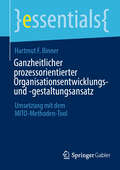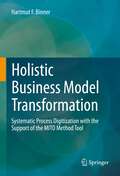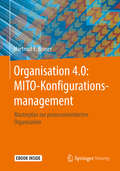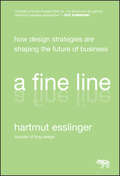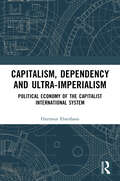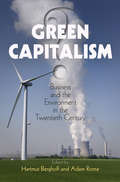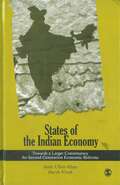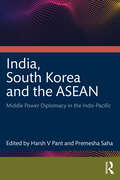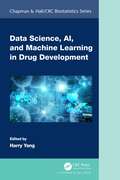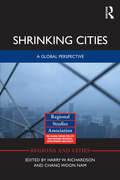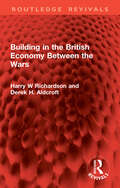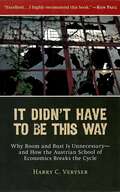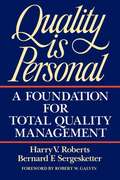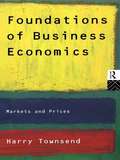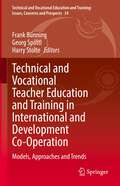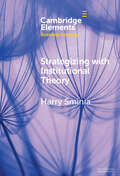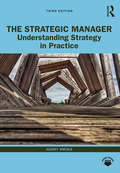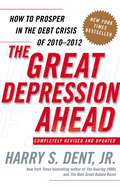- Table View
- List View
Ganzheitlicher prozessorientierter Organisationsentwicklungs- und -gestaltungsansatz: Umsetzung mit dem MITO-Methoden-Tool (essentials)
by Hartmut F. BinnerUnternehmen aller Branchen müssen sich aufgrund der digitalen Transformation damit beschäftigen, neue Geschäftsmodelle zu entwickeln, um aufgrund von disruptiven Veränderung der bestehenden Produkt- oder Servicelösungen weiterhin wettbewerbsfähig zu bleiben. Die Entwicklung von digitalen Business(Geschäfts)modellen ist jedoch ein herausfordernder Lösungsansatz. Denn es müssen klare Vorstellungen über die Infrastrukturen, Inhalte und Aussagen vorliegen, über die ein Geschäftsmodell verfügen sollte, um darauf aufbauend die richtigen digitalen Geschäftsinnovationen und -strategien aufzusetzen. Mit dem regelkreisorientierten MITO-Modell (bestehend aus den Elementen Management, Input, Transformation, Output) wird ein allgemeingültiger Bezugs- und Ordnungsrahmen für die prozessorientierte Organisations-Implementierung vorgegeben.
Holistic Business Model Transformation: Systematic Process Digitization with the Support of the MITO Method Tool
by Hartmut F. BinnerThis book describes the control loop-oriented change management process for implementing a digital business model via the holistic Organization 4.0 MITO configuration management. The content chapter structure of this MITO book with the description of the different transformation design views is based on the higher-level operational control loop principle within the MITO model segments shown in Figure 1. Whereby the management segment (M) is still subdivided on the default side into the process-related management segment and on the feedback side into the fact-related management segment. The MITO business model based on this supplements the 5 model segments with the downstream customer and upstream supplier segments and integrates the hierarchical process level model into the MITO model representation for the conception of the process-oriented target, management and control system.This book is a translation of the original German 1st edition Ganzheitliche Businessmodell-Transformation by Hartmut F. Binner, published by Springer Fachmedien Wiesbaden GmbH, part of Springer Nature in 2020. The translation was done with the help of artificial intelligence (machine translation by the service DeepL.com). A subsequent human revision was done primarily in terms of content, so that the book will read stylistically differently from a conventional translation. Springer Nature works continuously to further the development of tools for the production of books and on the related technologies to support the authors.
Nachhaltige MITO-Businessmodell-Transformation: Systematische Umsetzung mit dem MITO-Methoden-Tool
by Hartmut F. BinnerEntscheidungen in Unternehmen haben Auswirkungen auf die Gesellschaft und die Umwelt. Unternehmen müssen solche Auswirkungen ernst nehmen und Nachhaltigkeitsthemen in der Organisation und den Geschäftstätigkeiten berücksichtigen sowie geeignete Maßnahmen treffen (Corporate Social Responsibility – CSR). Entsprechend geht dies mit Transformationen einher, die vielfältige Herausforderungen hinsichtlich Bewertung und Entscheidungsfindung mit sich bringen. Dieses Buch beschreibt einen ganzheitlichen Ansatz zur Businessmodell-Nachhaltigkeitsgestaltung mit dem Ziel einer Integration aller Nachhaltigkeitsthemen. Eingesetzt wird das MITO-Methoden-Tool, das sich streng an den Vorgaben der DIN ISO 26000, den dort genannten Kernthemen der Nachhaltigkeit, den Handlungsempfehlungen und auch weiterführenden Nachhaltigkeitsregelwerken orientiert.
Organisation 4.0: Masterplan zur prozessorientierten Organisation
by Hartmut F. BinnerWie Unternehmen die Herausforderungen, mit denen sie konfrontiert sind, erfolgreich managen können, beschreiben unzählige Ratgeber.Dieses Buch stellt im Detail den Weg dorthin, das „Wie“, in den Vordergrund. Der Autor verfolgt dabei einen ganzheitlichen, prozessorientierten Ansatz der Organisationsentwicklung.In dem Buch wird der Weg von einer funktionsorientierten hin zu einer prozessorientierten Organisation detailliert und anhand von vielen Anwendungsbeispielen beschrieben. Der Autor stellt Modelle, Methoden, Vorgehensweisen und Tools für die Umsetzung vor. Das MITO-Modell mit seinem Methoden-Tool als generischem Methodenbaukasten wird umfassend erläutert. Bezugspunkt für das Changemanagement ist dabei nicht die vertikale, also hierarchische Organisationsstruktur, sondern, ausgehend von einer rollenbasierten Ordnungsstruktur, die horizontale Wertschöpfungskette. Erst aus dieser detaillierten rollenbasierten Beschreibung des End-to-End-Businessprozesseses ergeben sich die Prozessaufgaben und Prozessverantwortlichkeiten. Dies wiederum ermöglicht eine hohe Datendurchgängigkeit für die Prozessdigitalisierung mit neuen Technologien wie Cloud Computing, Enterprise Mobility, Social Business, Big Data in der Organisation 4.0.In dem Buch werden alle Fragen rund um das gemeinsame Führungsverständnis in einer prozessorientierten Organisation besprochen. Auch der Aufbau einer gemeinsamen Wissens- und Lernplattform zur Qualifizierung von Führungskräften und Mitarbeitern wird behandelt. Wie lassen sich Prozesse systematisch beschreiben und im Rahmen eines ganzheitlichen Business Process Management (BPM) umsetzen? Wie können funktionsorientierte Veränderungs-, Anforderungs- und Auswirkungsanalysen durch prozessorientierte Analysen ersetzt werden? Wie lässt sich eine prozessorientierte Organisation evaluieren? Das Buch analysiert diese und weitere Fragen systematisch und detailliert und vermittelt Führungskräften nicht nur das notwendige Wissen, sondern auch die Methodenkompetenz, um Changemanagement-Prozesse umzusetzen.Ob Mittelstand oder Großunternehmen – das Buch richtet sich an alle Führungskräfte in Unternehmen, die sich mit Changemanagement auseinandersetzen.
A Fine Line
by Hartmut Esslingerpraise for a fine line "A breath of turbo-charged fresh air that doesn't regurgitate the ego-maniac CEO's selective memory or an outside expert's misinterpretations. Hartmut explains innovation through the lens of design, and it's about time we gained his valuable perspective. " -Guy Kawasaki, former chief evangelist, Apple and co-founder of Alltop. com "At Flextronics, we fell in love with Hartmut and frog, and their passion for bringing crazy great designs and design processes into the forefront of great product companies. We used their expertise to help our customers, many of the greatest product companies in the world, including Apple, HP, Cisco, Microsoft and others. It is a credit to Hartmut that in the midst of a shocking global recession, frog still sets quarterly revenue records. Theirs is a unique and fascinating story. " -Michael Marks, partner, Riverwood Capital LLC and former CEO, Flextronics "Hartmut's new approach to design is felt in every room in every house in every country and in every business around the world. He proved that thoughtful design is not only good for people but is good for business-and that both are interlinked. I have been fortunate to have observed first hand his impact at Sony, Apple, and HP?and have learned so much from him. He is an unsung hero of our times! A Fine Line is a must-read for designers and business people alike. " -Satjiv Chahil, senior vice president, Hewlett-Packard "A fascinating, breathtaking, and exemplary insight into a success story that never had so much topicality, and so much informative potential as just now. Esslinger offers an honest and encouraging portrait of the incredible power of the business and design alliance. A Fine Line is a handbook of design expertise and the art of business at its best, showing a variety of radical solutions and fresh new ideas. " -Professor Dr Peter Zec, president, ICSID and founder, red dot awards
Capitalism, Dependency and Ultra-Imperialism: Political Economy of the Capitalist International System
by Hartmut ElsenhansThis book assembles main contributions to an alternative explanation of globalisation and the political economic structures of the international system. As the result of capitalism, globalisation does not transfer basic capitalist structures from the Centre to the Periphery. Capitalism is based on rising mass incomes that create investment opportunities and, thus, the possibility of profit. A structurally homogeneous and ultraimperialist Centre dominates a deeply fissured Periphery of structurally heterogeneous societies and economies. Capitalism penetrates underdeveloped regions and deforms them through rent, which obstructs expanding internal mass markets while labour goes unempowered. Rent constitutes the basis for state operations and the role of emerging state classes. While globalisation disempowers labour in both the West and in the South, it has given new comparative advantage to the South. The shift from rent appropriation in the South via raw material exports to export-led manufacturing is based on devaluation below purchasing power parity and, hence, on a rent from agriculture that is based on the Green Revolution. Its impact is, however, not always sufficient to compensate for the loss of influence experienced by social reformist forces. A novel multipolar system based on the balance power has emerged. Mutliethnic empires are held together with large varieties of however always identitarian ideologies. This global system is composed of powers that are internally and externally opposed to peaceful change. Across the globe, there is an impending danger of globalisation of rent. Print edition not for sale in South Asia (India, Sri Lanka, Nepal, Bangladesh, Pakistan and Bhutan)
Capitalism, Development and Empowerment of Labour: A Heterodox Political Economy (Routledge Frontiers of Political Economy)
by Hartmut ElsenhansThe dominant neoliberal approach presents politics and political economy as nuisances which disturb the smooth operation of self-regulating markets. But political economy is not merely an academic issue – it is a class issue, and this book forcefully argues that political economy should return to a central position in the study of the social sciences. Offering nothing less than a reconciliation of Marxian, Keynesian and neoclassical economics, the work opens with a discussion of the key, interconnected economic concepts which help us to understand capitalism: price, income, profit, value, growth and crisis. Prices reflect income distribution and therefore class relations, and the chapters show that the very emergence of capitalism resulted from mass empowerment of the so-called "lower orders". Profit is always available if entrepreneurs spend on net investment and create incomes for additional labour; this, in turn, requires expanding demand, and so therefore profit depends on rising mass incomes. Conversely, underdevelopment is the result of the destitution and disempowerment of the masses. In the Global South today, it is clear that enormous riches go hand in hand with widespread misery and poverty because the market does not transform wealth into the kind of investment that might benefit all. This book argues that the new wealth triggered by productivity increases has enabled the rich to liberate themselves from the capitalist constraints of competition and waste their new wealth in the form of rents. The main threat today is, in fact, the globalisation of rent. The text makes a point for a progressive counter strategy: capitalist structures that empower labour need to be transferred to the Global South. This requires political and economic efforts towards empowering labour in the Global South. This book demonstrates the analytical power of political economy for all social scientists and will be invaluable reading for economists, political scientists and sociologists in particular.
Green Capitalism?: Business and the Environment in the Twentieth Century (Hagley Perspectives on Business and Culture)
by Adam Rome Hartmut BerghoffAt a time when the human impact on the environment is more devastating than ever, business initiatives frame the quest to "green" capitalism as the key to humanity's long-term survival. Indeed, even before the rise of the environmental movement in the 1970s, businesses sometimes had reasons to protect parts of nature, limit their production of wastes, and support broader environmental reforms. In the last thirty years, especially, many businesses have worked hard to reduce their direct and indirect environmental footprint. But are these efforts exceptional, or can capitalism truly be environmentally conscious?Green Capitalism? offers a critical, historically informed perspective on building a more sustainable economy. Written by scholars of business history and environmental history, the essays in this volume consider the nature of capitalism through historical overviews of twentieth-century businesses and a wide range of focused case studies. Beginning early in the century, contributors explore the response of business leaders to environmental challenges in an era long before the formation of the modern regulatory state. Moving on to midcentury environmental initiatives, scholars analyze failed business efforts to green products and packaging—such as the infamous six-pack ring—in the 1960s and 1970s. The last section contains case studies of businesses that successfully managed greening initiatives, from the first effort by an electric utility to promote conservation, to the environmental overhaul of a Swedish mining company, to the problem of household waste in pre-1990 West Germany. Ranging in geographic scope from Europe to the United States, Green Capitalism? raises questions about capitalism in different historical, sociocultural, and political contexts.Contributors: Hartmut Berghoff, Ann-Kristin Bergquist, Brian C. Black, William D. Bryan, Julie Cohn, Leif Fredrickson, Hugh S. Gorman, Geoffrey Jones, David Kinkela, Roman Köster, Joseph A. Pratt, Adam Rome, Christine Meisner Rosen.
States of the Indian Economy: Towards a Larger Constituency for Second Generation Economic Reforms
by Amir Ullah Khan Harsh VivekThe phenomenal rise of India in the global economy has been attributed to a whole host of factors, the major ones being the focus on economic reforms and the demographic dividend that India currently enjoys due to its demographic transition. The large pool of human capital - a young, talented and well-educated workforce - is one of the major drivers of economic growth in the country. Rapid strides in knowledge-based industries, especially information technology, biotechnology and pharmaceuticals; rejuvenation of the manufacturing sector, revolution in the agriculture sector; and, resurgence in exports have made India one of the fastest growing economies in the world. A market-oriented approach to development, opening up of the economy and the growing economies of scale and scope for Indian enterprises, access to ′modern′ technology - especially information technology - and growth in entrepreneurship have made India a sought-after destination for foreign investment. The authors argue that this situation is a result of the implementation of a set of first generation economic reforms, initiated primarily by the Central government but the responsibilities of which are now on the State governments. To carry the second generation of reforms forward in a meaningful manner, action has now shifted to the states. With this background, this book primarily examines the following: - The state of the Indian economy after one and a half decades of liberalisation and its role in the fast changing global economy - The economic performance of various Indian states during this period - Sectors that have done well and those that need substantial improvement in terms of adoption and implementation of reform measures.
Branding Demystified: Plans to Payoffs (Response Books)
by Harsh V VermaThe aspects of marketing surrounding a brand, like advertising, sales promotion and distribution, can mislead and confuse brand builders. Branding Simplified: Plans to Payoffs aims to dispel the cloud of these peripheral issues and clarify the foundations on which strong brands are built, with a distinct focus on the higher-order connect between the prospects and the brands. With the help of India-based examples and illustrations, the book analyses why brands have become indispensable in our lives. It communicates the key concepts of branding and branding strategy with an optimum degree of lucidity. The book focuses on the following important branding challenges: " Brand meaning " Brand vision " Brand transformation " Brand value in higher orbits " Brand strategy " Leveraging the brand " Brand adjustments The book will be immensely helpful to professionals in the fields of marketing, advertising, consulting, strategy, and so on, and to entrepreneurs. Teachers and students of business management, advertising and branding will find it an incisive and exhaustive text on brand-building and brand management.
India, South Korea and the ASEAN: Middle Power Diplomacy in the Indo-Pacific
by Harsh V PantWith the US-China geostrategic competition heating up, it is an opportune time for South Korea, ASEAN and India to draw on their middle power status to bolster regional security and economic cooperation to protect their interests from any potential superpower fallout. This book investigates the diverse possibilities for collaboration within the India-ASEAN-ROK trilateral framework. It explores the various avenues of cooperation that this new trilateral initiative can benefit from, ranging from security, economic, institutional platforms and technology to sustainable development and climate change. The book provides regional perspectives on India, ASEAN and ROK to show the growing appetite in these countries for such trilateral initiatives and to forecast the challenges that may arise.Lucid and topical, this book will be an essential read for scholars and researchers of political science, international relations, diplomacy and strategic studies, as well as Southeast Asian, East Asian and South Asian studies. It will also be of use to thinktanks and policymakers interested in Indo-Pacific, India-ASEAN and India-ROK issues.
Entscheidung und Steuerung in hybriden Windparks
by Dipankar Deb Harsh DhimanDieses Buch fokussiert auf zwei zentrale Aspekte im Betrieb von Windparks: Entscheidungen und Steuerung. Im ersten Teil werden Entscheidungsprozesse erläutert, bei denen der Betrieb von Hybrid-Windparks von der Auswahl optimaler Alternativen zur Einspeisung von Windenergie ins Netz abhängt. Präzise Windvorhersagen sind entscheidend, um Fehler auszugleichen und mittels eines Batteriespeichersystems Reservekapazitäten ins Netz einzuspeisen. MCDM-Methoden und ein unscharfer Ansatz werden verwendet, um die besten Optionen zu bewerten. Fallstudien aus US-amerikanischen Windparks bieten numerische Lösungen. Im zweiten Teil liegt der Fokus auf der Steuerung, insbesondere der Yaw-Winkel-Steuerung zur Leistungsoptimierung der Turbinen. Eine Transferfunktions-basierte Methode zur Steuerung des Wirbelzentrums wird vorgestellt, begleitet von lidar-basierten Simulationen und adaptiven Steuerungsstrategien für verschiedene Windparklayouts. Die Auswirkungen des Yaw-Winkels auf die Betriebskosten des Batteriespeichersystems werden analysiert, unterstützt durch Fallstudien aus den USA und Dänemark.
Data Science, AI, and Machine Learning in Drug Development (Chapman & Hall/CRC Biostatistics Series)
by Harry YangThe confluence of big data, artificial intelligence (AI), and machine learning (ML) has led to a paradigm shift in how innovative medicines are developed and healthcare delivered. To fully capitalize on these technological advances, it is essential to systematically harness data from diverse sources and leverage digital technologies and advanced analytics to enable data-driven decisions. Data science stands at a unique moment of opportunity to lead such a transformative change. Intended to be a single source of information, Data Science, AI, and Machine Learning in Drug Research and Development covers a wide range of topics on the changing landscape of drug R & D, emerging applications of big data, AI and ML in drug development, and the build of robust data science organizations to drive biopharmaceutical digital transformations. Features Provides a comprehensive review of challenges and opportunities as related to the applications of big data, AI, and ML in the entire spectrum of drug R & D Discusses regulatory developments in leveraging big data and advanced analytics in drug review and approval Offers a balanced approach to data science organization build Presents real-world examples of AI-powered solutions to a host of issues in the lifecycle of drug development Affords sufficient context for each problem and provides a detailed description of solutions suitable for practitioners with limited data science expertise
A Practical Guide to the Insurance Act 2015 (Practical Insurance Guides)
by David Kendall Harry WrightThe Insurance Act 2015 ('the Act') is the first comprehensive statutory reform of the insurance law of the United Kingdom since the Marine Insurance Act 1906. It introduces thorough and, in some cases, fairly drastic reform of some of the core tenets of UK insurance law, including: the insured’s pre-contractual duty to the insurer, and remedies for its breach; the knowledge of the insured and the insurer for the purposes of the pre-contractual duty; the effect of insurance warranties and other terms tending to reduce the risk of loss; fraudulent claims; and damages for failure to pay an insurance claim in a reasonable time. This book is a thorough introduction to the Act. It focuses primarily on the impact of the Act on English law as applied to non-consumer insurance and reinsurance. Of assistance not only to insurance lawyers and members of the judiciary, but also underwriters, claims handlers, brokers and buyers of non-consumer insurance policies, this book covers each of the core changes brought about by the Act. It also analyses the particular ways in which the Act differs from existing law, by reference to the Marine Insurance Act 1906, and cases decided under the old law.
Shrinking Cities: A Global Perspective (Regions and Cities)
by Harry W. Richardson Chang Woon NamThis book examines a rapidly emerging new topic in urban settlement patterns: the role of shrinking cities. Much coverage is given to declining fertility rates, ageing populations and economic restructuring as the factors behind shrinking cities, but there is also reference to resource depletion, the demise of single-company towns and the micro-location of environmental hazards. The contributions show that shrinkage can occur at any scale – from neighbourhood to macro-region - and they consider whether shrinkage of metropolitan areas as a whole may be a future trend. Also addressed in this volume is the question of whether urban shrinkage policies are necessary or effective. The book comprises four parts: world or regional issues (with reference to the European Union and Latin America); national case studies (the United States, India, China, Korea, Taiwan, Germany, Romania and Estonia); city case studies (Detroit, Buffalo, Cleveland, Naples, Belfast and Halle); and broad issues such as the environmental consequences of shrinking cities. This book will be of interest to scholars and practitioners working in the fields of urban studies, economic geography and public policy.
Building in the British Economy Between the Wars (Routledge Revivals)
by Derek H. Aldcroft Harry W RichardsonOriginally published in 1968 this important work covers a crucial period in Britain’s economic history. In the three or four decades before the First World War British industry was subject to increasing foreign competition particularly from America and Germany. This book reviews the main developments in 10 industries, paying particular attention to the way in which they were affected by foreign competition, and the measures taken to combat it. Each case is analysed in terms of how progressive the British industrialists were and to what extent they were willing to innovate or alter their methods to meet the new conditions. In cases where a lack of enterprise was clear, the contributors have tried to determine what the major factors were which governed the pace of innovation. The book will be of interest to economists, economic historians and sociologists as well as those interested in industrial innovation.
It Didn't Have to Be This Way: Why Boom and Bust Is Unnecessary—and How the Austrian School of Economics Breaks the Cycle
by Harry Veryser"Excellent . . . I highly recommend this book." —RON PAUL Why is the boom-and-bust cycle so persistent? Why did economists fail to predict the economic meltdown that began in 2007—or to pull us out of the crisis more quickly? And how can we prevent future calamities? Mainstream economics has no adequate answers for these pressing questions. To understand how we got here, and how we can ensure prosperity, we must turn to an alternative to the dominant approach: the Austrian School of economics. Unfortunately, few people have even a vague understanding of the Austrian School, despite the prominence of leading figures such as Nobel Prize winner F. A. Hayek, author of The Road to Serfdom. Harry C. Veryser corrects that problem in this powerful and eye-opening book. In presenting the Austrian School&’s perspective, he reveals why the boom-and-bust cycle is unnatural and unnecessary. Veryser tells the fascinating (but frightening) story of how our modern economic condition developed. The most recent recession, far from being an isolated incident, was part of a larger cycle that has been the scourge of the West for a century—a cycle rooted in government manipulation of markets and currency. The lesson is clear: the devastation of the recent economic crisis—and of stagflation in the 1970s, and of the Great Depression in the 1930s—could have been avoided. It didn&’t have to be this way. Too long unappreciated, the Austrian School of economics reveals the crucial conditions for a successful economy and points the way to a free, prosperous, and humane society.
Quality Is Personal: A Foundation for Total Quality Management
by Harry V. RobertsIn this penetrating guide to involving employees in the process of total quality management, the authors make the argument that "personal quality checklists"--by which employees monitor waste reducers and value adding activities in their immediate work environment--can significantly increase individual understanding of the general concepts and implementation of top quality management.
Foundations of Business Economics: Markets and Prices
by Harry TownsendFoundatioins of Business Economics explains microeconomic analysis in terms of real business situations. The underlying theme of the book is the way in which markets link together interdependent activities and how they confront and solve problems of information. The book covers a wide range of issues, including *The economic way of thinking *The Business environment *Product markets *Market failure *Factor markets *General equilibrium Theory is developed carefully but with a light touch and mathematics kept to a minimum, making the book easily accessible. It will be particularly valuable for those students whose interests lie on the human side of industry. explanation of microeconomic analysis in terms of real business practice. The author examines the way markets link together interdependent economic activities and provides general equilibrium models of the entire economic system.
Technical and Vocational Teacher Education and Training in International and Development Co-Operation: Models, Approaches and Trends (Technical and Vocational Education and Training: Issues, Concerns and Prospects #34)
by Georg Spöttl Frank Bünning Harry StolteThis book deals with teacher training for vocational education and training. In individual chapters next to the positions of relevant international organizations, donors and development banks, it also covers selected countries in their ways of shaping of Technical Vocational Education and Training and teacher training. The structure of the book aims at two objectives: To outline positions of important stakeholders of the international Technical Vocational Education and Training policies and international cooperation in TVET teacher training.To discuss the current status of Technical Vocational Education and Training and teacher training in selected countries, from developing countries, countries with emerging economies to industrialized countries.The book is meant to create a platform that supports a reference concept within international cooperation for the further development of Technical Vocational Education and Training and teacher training up to a higher quality and performance.
Strategizing With Institutional Theory (Elements in Business Strategy)
by Harry SminiaThis text consults seven variants of institutional theory to explore how these can be applied to strategic management. These variants are New Institutional Economics, Old Institutionalism, New Institutionalism, institutional entrepreneurship and change, intra organizational institutionalization, institutional logics, and institutional work. In doing so, three strategic management styles are distinguished: competitiveness based strategic management, legitimacy based strategic management, and performativity based strategic management. While the competitive based style sees institutional theory submitting to mainstream strategy research, offering additional variables and considerations to explain competitive advantage, the legitimacy based style makes institutional theory a strategy theory in its own right by providing an explanation for an organization's viability that emphasizes legitimacy over competitive advantage. The performativity based style is an even more radical departure from mainstream strategizing by purporting that a future is actively created with organizations making contributions as emerging issues are being dealt with.
The Strategic Manager
by Harry SminiaStrategy is something with which managers regularly engage throughout their working lives, yet it is often written and researched as though periodic box-ticking exercises are the only show in town. This textbook provides students and professionals with a solid understanding of the strategic management theories, along with the tools needed to apply them and contribute toward successful organizations. The author starts from how strategy is realized in the business world and applies the key theories to provide a rounded understanding. Contemporary cases studies are provided to help readers visualize the application of strategic thinking. Including the various stakeholders, organizational politics and culture, the author opens a window to the real world of strategic management. Primarily aimed at postgraduate students and those in executive education, this textbook will also be useful as a handbook for managers looking to get their heads around this easily confused subject.
The Strategic Manager: Understanding Strategy in Practice
by Harry SminiaThe Strategic Manager provides a comprehensive, logical, and applied insight in strategic management. Unlike some more theory-heavy texts, this book focuses on how strategy works in everyday practice, taking readers’ expectations and understanding beyond that of strategy as a matter of planning only. It enables the reader to learn and reflect upon their practical skills and knowledge, and critically evaluate the strategy process and their own strategic decision-making. The book is based around six different strategy theories, individually presented and supplemented with useful lists of questions that encourage readers to become competent strategic thinkers. This third edition has been fully updated throughout, including fresh case studies and examples from across Asia, Africa, and South America that bridge theory with practice, new strategy practice boxes considering the importance of cooperation and strategic alliances, and reflective questions to aid understanding. Essential reading for postgraduate students of strategic management, MBA students, and those in executive education, this text will also be a useful tool for reflective managers trying to develop a better understanding. Online resources include chapter-by-chapter PowerPoint slides.
How to Talk Your Way to Success
by Harry SimmonsHave you ever stopped to think how much “talk” occurs in our own little busy world every day of our lives?Do you realize how much talk is involved in our jobs in everyday business? How everything we do every day of our lives involves conversation and speech on many different topics?Our conversations in our household and community affairs, at our desk in the office, out in the factory or on the road, with our fellow workers, executives, vendors, customers, visitors, friends—all these involve thousands of words every day in our lives.Imagine what help it might be to your prospects of success if all your talk and conversation were consciously directed to specific objectives and goals of accomplishment. Think of the pleasant and desirable things that might happen if your talks, your conversations, your letters, your telephone messages, your public appearances all were consciously channeled along the road to success.This book has as its major purpose the directing of all these words into proper, efficient, and effective lines of communication.
The Great Depression Ahead: How to Prosper in the Crash Following the Greatest Boom in History
by Harry S. Dent Jr.The first and last economic depression that you will experience in your lifetime is just ahead. The year 2009 will be the beginning of the next long-term winter season and the initial end of prosperity in almost every market, ushering in a downturn like most of us have not experienced before. Are you aware that we have seen long-term peaks in our stock market and economy very close to every 40 years due to generational spending trends: as in 1929, 1968, and next around 2009? Are you aware that oil and commodity prices have peaked nearly every 30 years, as in 1920, 1951, 1980 -- and next likely around late 2009 to mid-2010? The three massive bubbles that have been booming for the last few decades -- stocks, real estate, and commodities -- have all reached their peak and are deflating simultaneously. Bestselling author and renowned economic forecaster Harry S. Dent, Jr., has observed these trends for decades. As he first demonstrated in his bestselling The Great Boom Ahead, he has developed analytical techniques that allow him to predict the impact they will have. The Great Depression Ahead explains "The Perfect Storm" as peak oil prices collide with peaking generational spending trends by 2010, leading to a more severe downtrend for the global economy and individual investors alike. He predicts the following: The economy appears to recover from the subprime crisis and minor recession by mid-2009 -- "the calm before the real storm." Stock prices start to crash again between mid- and late 2009 into late 2010, and likely finally bottom around mid-2012 -- between Dow 3,800 and 7,200. The economy enters a deeper depression between mid-2010 and early 2011, likely extending off and on into late 2012 or mid-2013. Asian markets may bottom by late 2010, along with health care, and be the first great buy opportunities in stocks. Gold and precious metals will appear to be a hedge at first, but will ultimately collapse as well after mid- to late 2010. A first major stock rally, likely between mid-2012 and mid-2017, will be followed by a final setdback around late 2019/early 2020. The next broad-based global bull market will be from 2020-2023 into 2035-2036. Conventional investment wisdom will no longer apply, and investors on every level -- from billion-dollar firms to the individual trader -- must drastically reevaluate their policies in order to survive. But despite the dire news and dark predictions, there are real opportunities to come from the greatest fire sale on financial assets since the early 1930s. Dent outlines the critical issues that will face our government and other major institutions, offering long- and short-term tactics for weathering the storm. He offers recommendations that will allow families, businesses, investors, and individuals to manage their assets correctly and come out on top. With the right knowledge and preparation, you can take advantage of new wealth opportunities rather than get caught in a downward spiral. Your life is about to change for reasons outside of your control. You can't change the direction of the winds, but you can reset your sails!
